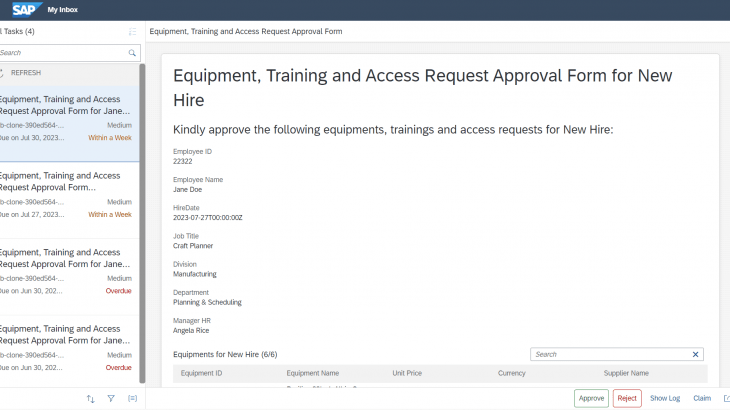Introduction:
Enterprise automation is a key driver for organizations aiming to stay ahead in a competitive landscape. It involves identifying and automating business and IT tasks to streamline operations, increase efficiency, and improve business outcomes. SAP provides a comprehensive solution to enable enterprise automation, encompassing various components.
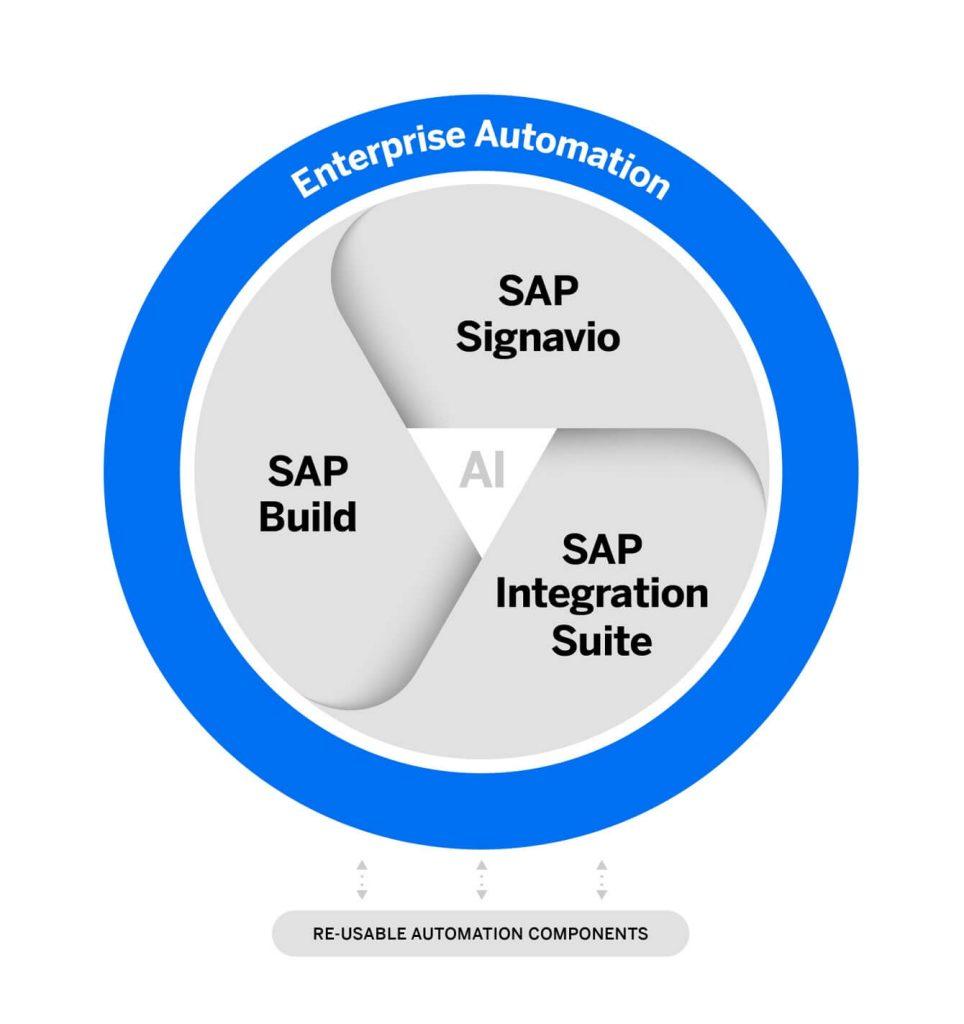
One essential element is SAP Integration Suite, which serves as an integration platform-as-a-service (iPaaS). It offers pre-built integrations, APIs, and connectors to seamlessly connect SAP and non-SAP applications, reducing complexity across on-premises and multi-cloud environments.
Another integral part is SAP Signavio, which empowers organizations with visibility into their business processes. It helps identify potential bottlenecks, perform root-cause analysis, and offers suggestions for improvement based on industry benchmarks and best practices.
Furthermore, SAP Build provides a low-code solution for creating automations and applications. With a user-friendly drag-and-drop interface, business experts can rapidly address process inefficiencies and build customized automations. SAP Build also includes pre-built automations and connectors for both SAP and non-SAP systems.
By leveraging these components, organizations can gain valuable insights into their processes, automate tasks, and achieve optimized efficiency without introducing complexity to their existing IT landscape. Enterprise automation with SAP enables businesses to drive digital transformation, increase productivity, and deliver superior outcomes.
Business Problem:
The onboarding process is a crucial activity in any organization, influencing the experience and success of new hires. I personally am a working student at sap, who rotates every 6months to a new department. As a result of this, I regularly face the onboarding process with new trainings and system accesses required in order to support the team. From this experience I can say, if not done right, the onboarding process can involve manual and repetitive tasks, leading to inefficiencies and delays. This is why organizations need a solution that enables seamless integration, process automation, and customization to provide a personalized onboarding experience for new hires.
Solution:
The SAP Integration Suite, in combination with SAP Build Process Automation and SAP Signavio, offers a comprehensive solution to address the challenges in the onboarding process. By leveraging event-based integration patterns, low-code/no-code workflows, and the power of the Business Technology Platform, organizations can extend and customize the onboarding experience, integrate with third-party tools, automate activities, and streamline shared-service processes.
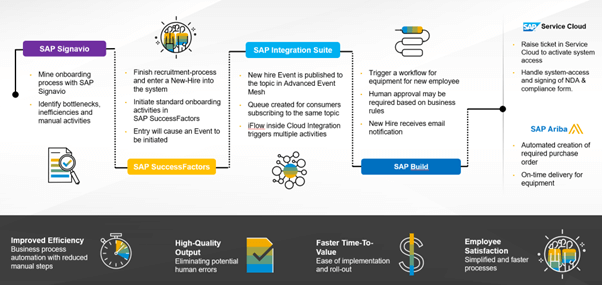
Step-by-Step Workflow:
Step 1. Identify Process Gaps: Utilize SAP Signavio Process Intelligence to analyze the onboarding process, identify inefficiencies, and gain insights into manual and repetitive tasks. The following manual steps can be identified:
- Requesting equipment for New-Hires
- Raising service tickets for system access
- Setting up employees with external benefits providers
- Assigning the correct enablement training for the new hires
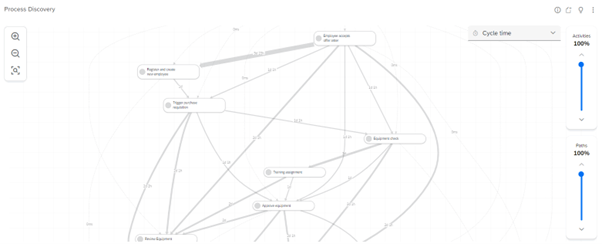

Step 2. Subscribe to business events in SAP SuccessFactors:
The process starts with adding a new hire in SAP SuccessFactors. The information will be put in directly in the system. To automate this process, we will leverage the Advanced Event Mesh and subscribe to SAP SuccessFactors, which enables communication and triggering of workflows across systems. Whenever a new hire is added an event is created which will be needed for triggering a workflow.
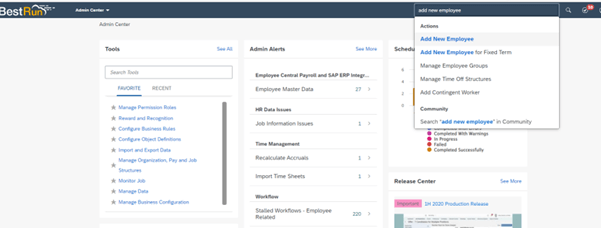
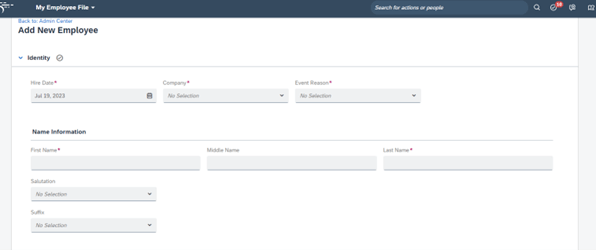
The Advanced Event Mesh is a core functionality of the SAP Integration Suite, it ensures that the right amount of information is sent to the right place as soon as the event happens.
Step 3. Orchestrate system integration with SAP Integration Suite:
In order to take care of the integration between the different systems, Integration Suite can be leveraged. The user will define different iFlows that are taking care of multiple activities at the same time – for example to trigger the workflow in SAP Build Process Automation or to transfer data to non-SAP systems as well.
SAP Integration Suite comes with a versatile, multi-cloud platform to support all types of integration use cased required in cloud and hybrid landscapes. Streamline Any-to-Any, SAP and third-party and data across diverse application landscapes with comprehensive integration capabilities, connectors and adapters.
Step 4. Leverage Low Code/ No Code to design custom processes:
Use custom workflows in SAP Build Process Automation (SBPA) to automate the processes. First the process will be modeled using Drag & Drop and then artifacts will be leveraged to complete the business need. Here is an overview of all the artifacts:
- API-Trigger:
- API-Triggers are used to directly invoke executions for integrations
- We configured an API-Trigger to initiate a workflow instance from SAP Integration Suite
- API-Triggers are used to directly invoke executions for integrations
- Business Rules:
- Business Rules are the criteria or conditions which determine the outcome of a decision process
- Decision Tables were used to determine the right equipment and the right training assignment depending on the job-role and the manager
- Business Rules are the criteria or conditions which determine the outcome of a decision process
- Condition:
- statements that are created which evaluate actions in the program and determine if it’s true or false
- Different workflow logic is used for employees that start as Data Scientists
- statements that are created which evaluate actions in the program and determine if it’s true or false
- Subworkflows:
- Subworkflows allow the process designer to separate process steps in subordinate activities
- Here we have used a subworkflow to manage different processes for Data Scientists
- Subworkflows allow the process designer to separate process steps in subordinate activities
- Approval-Form:
- An Approval-Form is a document which will be sent to a defined persons inbox and requires an action from the approver
- We used the LCNC Forms-Designer to get the approval from the HR-Business Partner
- An Approval-Form is a document which will be sent to a defined persons inbox and requires an action from the approver
- Actions:
- You can embed external skills and capabilities into your SAP Build Process Automation projects using actions.
- With this remote call we are triggering a new iFlow in SAP Integration Suite to post the Purchase Requisition in Ariba and to create a Ticket in SAP Service Cloud.
- You can embed external skills and capabilities into your SAP Build Process Automation projects using actions.
- Mail-Task:
- A Mail Task will automatically send a predefined E-Mail to a certain group of people
- We can use SMTP to directly send out Mail notification to all the stakeholders if a workflow has been approved or rejected.
- A Mail Task will automatically send a predefined E-Mail to a certain group of people
Here you can see the process in the low-code no-code environment of SAP Build Process Automation.
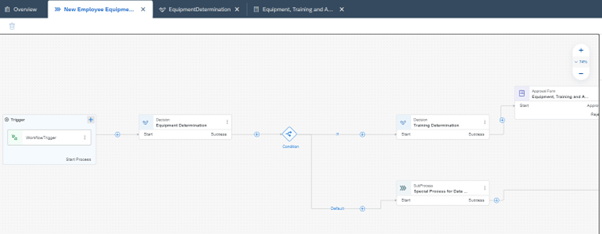
Here you can see the point of view for the HR Business Partner that would approve the workflow.
This includes the equipment, training and system access requests.
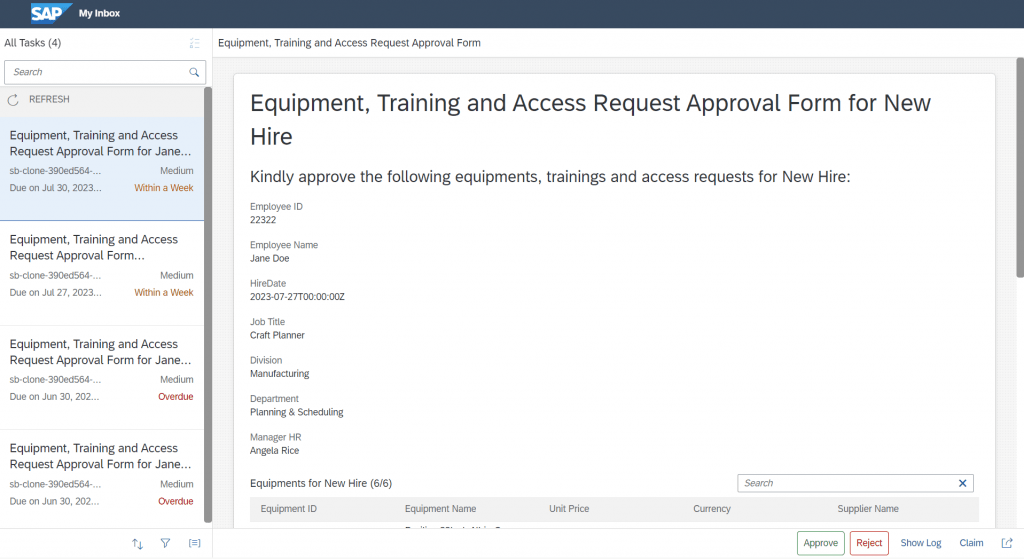
Step 5. Automatically create an Ariba Purchase Requisition:
Once the process in SAP Build Process Automation is started by an event, different tasks will automatically be triggered. For example, an Ariba Purchase Requisition will be created to automate the equipment procurement.

Step 6. Automatically create a service ticket in the SAP Service Cloud:
Another task that is automatically triggered is the creation of a service ticket in the SAP Service Cloud. This ticket can take care of for example system authorizations, NDAs and Compliance forms.

